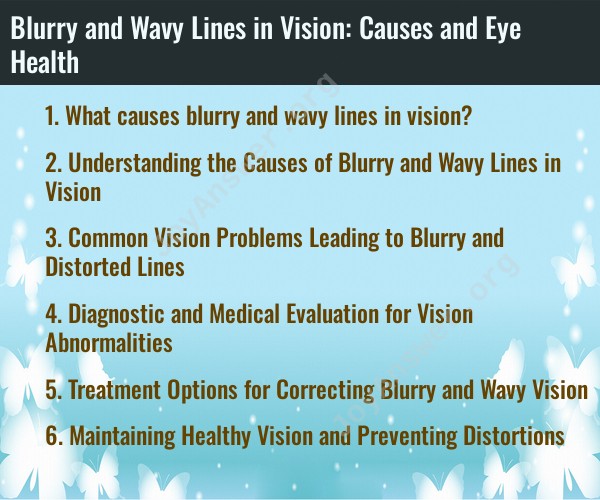What causes blurry and wavy lines in vision?
Experiencing blurry and wavy lines in your vision can be a concerning symptom that may indicate various underlying eye or health conditions. It's essential to consult with an eye care professional, such as an optometrist or ophthalmologist, to determine the exact cause and receive appropriate treatment. Here are some possible causes of blurry and wavy lines in vision:
Migraine Aura: Some individuals experience visual disturbances, including wavy lines or shimmering lights, known as an "aura," before the onset of a migraine headache. This is typically temporary and is associated with the headache phase.
Retinal Detachment: Retinal detachment occurs when the retina, the light-sensitive tissue at the back of the eye, becomes separated from its normal position. This condition can lead to sudden and severe visual symptoms, including the perception of wavy lines. Retinal detachment is a medical emergency and requires immediate attention.
Macular Degeneration: Age-related macular degeneration (AMD) is a leading cause of vision loss among older adults. AMD can cause wavy or distorted central vision. There are two main types: dry AMD and wet AMD, with the latter being more severe and associated with sudden changes in vision.
Retinal Edema: Swelling of the retina, known as retinal edema, can lead to distorted or wavy vision. It may be caused by various factors, including diabetic retinopathy, retinal vein occlusion, or other retinal conditions.
Medications and Drug Side Effects: Some medications or recreational drugs can cause changes in vision, including blurred and wavy lines, as a side effect. If you suspect a medication is causing this, consult with your healthcare provider.
Ocular Migraine: Ocular migraines are characterized by visual disturbances, such as wavy lines, that affect one eye. These symptoms are typically temporary and can resolve on their own.
Optical Distortion: Sometimes, blurry and wavy lines may be related to issues with eyeglass or contact lens prescriptions. If your prescription is incorrect or outdated, it can affect your vision.
Central Serous Retinopathy (CSR): CSR is a condition in which fluid accumulates under the retina, leading to blurred or distorted central vision. It often resolves on its own but should be evaluated by an eye care professional.
Hypertensive Retinopathy: Elevated blood pressure can affect the small blood vessels in the eyes, leading to wavy or distorted vision. It is more common in individuals with uncontrolled high blood pressure.
Ocular Infections or Inflammation: Conditions such as uveitis or other inflammatory eye diseases can cause visual disturbances, including blurred and wavy lines.
Given the potential seriousness of some of these conditions, if you experience sudden or persistent blurry and wavy lines in your vision, it is crucial to seek immediate medical evaluation. A comprehensive eye examination will help determine the underlying cause and guide appropriate treatment or management to preserve your eye health and vision.
Understanding the Causes of Blurry and Wavy Lines in Vision
Blurry and wavy lines in vision are common symptoms of a variety of eye problems. Some of the most common causes include:
- Astigmatism: Astigmatism is a refractive error that causes the cornea to be irregularly shaped. This can cause light rays to focus at multiple points in the eye, resulting in blurry and distorted vision.
- Cataracts: Cataracts are a clouding of the lens of the eye. This can cause light rays to scatter, which can also lead to blurry and distorted vision.
- Diabetic retinopathy: Diabetic retinopathy is a complication of diabetes that can damage the retina, the light-sensitive tissue at the back of the eye. This can cause a variety of vision problems, including blurry and wavy vision.
- Glaucoma: Glaucoma is a group of eye diseases that can damage the optic nerve, which carries visual information from the eye to the brain. This can lead to vision loss, including blurry and wavy vision.
- Macular degeneration: Macular degeneration is an age-related eye disease that damages the macula, the central part of the retina. This can cause blurry and distorted vision in the central field of vision.
Other causes of blurry and wavy lines in vision can include:
- Dry eyes
- Eye strain
- Migraine headaches
- Multiple sclerosis
- Stroke
Common Vision Problems Leading to Blurry and Distorted Lines
The most common vision problems that lead to blurry and distorted lines are astigmatism, cataracts, diabetic retinopathy, glaucoma, and macular degeneration.
- Astigmatism is a refractive error that affects the shape of the cornea, the clear front part of the eye. With astigmatism, the cornea is not perfectly round, but is shaped more like a football. This causes light to be focused at multiple points in the eye, rather than at a single point, resulting in blurry and distorted vision.
- Cataracts are a clouding of the lens of the eye. As we age, the proteins in the lens can break down and clump together, forming a cataract. This can cause the lens to become cloudy and block light from reaching the retina, resulting in blurry vision.
- Diabetic retinopathy is a complication of diabetes that damages the blood vessels in the retina. This can cause the blood vessels to leak fluid or blood into the retina, or to grow new abnormal blood vessels. This can damage the retina and lead to vision problems, including blurry vision, blind spots, and floaters.
- Glaucoma is a group of eye diseases that damage the optic nerve, the nerve that carries visual information from the eye to the brain. There are two main types of glaucoma: open-angle glaucoma and angle-closure glaucoma. With open-angle glaucoma, the fluid in the eye does not drain properly, which increases the pressure inside the eye and damages the optic nerve. With angle-closure glaucoma, the iris blocks the drainage angle of the eye, which also increases the pressure inside the eye and damages the optic nerve.
- Macular degeneration is an age-related eye disease that damages the macula, the central part of the retina. The macula is responsible for central vision, which is needed for tasks such as reading, driving, and seeing faces. With macular degeneration, the macula can become damaged, resulting in blurry vision in the central field of vision.
Diagnostic and Medical Evaluation for Vision Abnormalities
If you are experiencing blurry and wavy lines in vision, it is important to see an eye doctor for a comprehensive eye exam. The eye doctor will perform a variety of tests to assess your vision and to determine the cause of your symptoms.
During the eye exam, the eye doctor will ask you about your medical history and symptoms. They will also perform a visual acuity test to measure the sharpness of your vision. Other tests that may be performed include:
- Refraction test: This test measures how well your eyes focus light.
- Slit-lamp exam: This exam uses a microscope to examine the front of your eyes, including the cornea, iris, and lens.
- Fundus exam: This exam uses a magnifying lens to examine the retina, optic nerve, and other blood vessels at the back of the eye.
Treatment Options for Correcting Blurry and Wavy Vision
The treatment for blurry and wavy lines in vision will depend on the underlying cause.
- Astigmatism can be corrected with glasses, contact lenses, or surgery.
- Cataracts can be treated with surgery to remove the cloudy lens and replace it with a clear artificial lens













